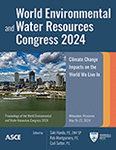Machine Learning-Based Land Cover Classification and Impact Assessment in Pre-Wildfire and Post-Wildfire Areas
Publication: World Environmental and Water Resources Congress 2024
ABSTRACT
Focused on assessing post-wildfire vegetation changes in Mount Charleston, this study utilized Landsat 8 imagery and machine learning models. The development of the training dataset relied on US Forest Service Landscape maps. Support vector machine (SVM) and neural network (NN) models were trained using Matlab Classification Learner. The SVM with linear kernel achieved an impressive 92.5% overall accuracy, effectively delineating fire-impacted areas, revealing a 25% reduction in trees and a 22% increase in barren lands. The SVM had a mean absolute error (MAE) of 0.1264 and a root mean square error (RMSE) of 0.41 for pre-fire classification, an MAE of 0.0718 and an RMSE of 0.3812 for post-fire state. The NN model with three layers demonstrated a 96.8% overall accuracy, indicating a post-fire conversion of dense vegetation to mixed barren shrubs. The model had an MAE of 0.0141 and an RMSE of 0.1393 for the pre-fire classification maps and an MAE of 0.0054 and an RMSE of 0.1019 for the post-fire classification. The tri-layered NN performed better than its SVM in terms of overall accuracy and MAE and RMSE. The spectral signature analysis identified challenges related to misclassifications, due to classes having similar spectral signatures emphasizing the need for a finer-resolution training dataset. These findings underscore the valuable role of machine learning models in understanding and quantifying wildfire-induced ecological impacts and how these changes can alter hydrological regimes.
Get full access to this chapter
View all available purchase options and get full access to this chapter.
REFERENCES
Benavides-Solorio, J., and MacDonald, L. H. (2001). Post-fire runoff and erosion from simulated rainfall on small plots, Colorado Front Range. Hydrological Processes, 15(15), 2931–2952. https://doi.org/10.1002/hyp.383.
Evenseth, M. H. (2023). Optical Remote Sensing of Oil Spills by using Machine Learning Methods in the Persian Gulf: A Multi-Class Approach [Master thesis, UiT The Arctic University of Norway]. https://munin.uit.no/handle/10037/29621.
Guo, Y., Zhang, L., Zhang, Y., Wang, Z., and Zheng, H. X. (2021). Estimating impacts of wildfire and climate variability on streamflow in Victoria, Australia. Hydrological Processes, 35(12), e14439. https://doi.org/10.1002/hyp.14439.
Maxwell, A. E., Warner, T. A., and Fang, F. (2018). Implementation of machine-learning classification in remote sensing: An applied review. International Journal of Remote Sensing, 39(9), 2784–2817. https://doi.org/10.1080/01431161.2018.1433343.
Radeloff, V. C., et al. (2018). Rapid growth of the US wildland-urban interface raises wildfire risk. Proceedings of the National Academy of Sciences, 115(13), 3314–3319. https://doi.org/10.1073/pnas.1718850115.
Richards, J. A. (2022). Supervised Classification Techniques. In J. A. Richards (Ed.), Remote Sensing Digital Image Analysis (pp. 263–367). Springer International Publishing. https://doi.org/10.1007/978-3-030-82327-6_8.
Shi, D., and Yang, X. (2017). Mapping vegetation and land cover in a large urban area using a multiple classifier system. International Journal of Remote Sensing, 38(16), 4700–4721. https://doi.org/10.1080/01431161.2017.1331059.
Smith, H. G., Sheridan, G. J., Lane, P. N. J., Nyman, P., and Haydon, S. (2011). Wildfire effects on water quality in forest catchments: A review with implications for water supply. Journal of Hydrology, 396(1), 170–192. https://doi.org/10.1016/j.jhydrol.2010.10.043.
Soulis, K., Valiantzas, J., and Dercas, N. (2010). Modelling forest fires hydrological impact using spatio-temporal geographical data. 193. https://scholarsarchive.byu.edu/iemssconference/2010/all/193.
Telfer, L. M. (2021). Exploring Hydrologic Responses to Different Wildfire Spatial Patterns Through the Lens of Computational Modeling [Master of Science in Hydrologic Sciences, Boise State University]. https://doi.org/10.18122/td/1894/boisestate.
Wang, J., Stern, M. A., King, V. M., Alpers, C. N., Quinn, N. W. T., Flint, A. L., and Flint, L. E. (2020). PFHydro: A New Watershed-Scale Model for Post-Fire Runoff Simulation. Environmental Modelling & Software, 123, 104555. https://doi.org/10.1016/j.envsoft.2019.104555.
Williams, C. J., Pierson, F. B., Robichaud, P. R., and Boll, J. (2014). Hydrologic and erosion responses to wildfire along the rangeland–xeric forest continuum in the western US: A review and model of hydrologic vulnerability. International Journal of Wildland Fire, 23(2), 155–172. https://doi.org/10.1071/WF12161.
Xie, Y., Sha, Z., and Yu, M. (2008). Remote sensing imagery in vegetation mapping: A review. Journal of Plant Ecology, 1(1), 9–23. https://doi.org/10.1093/jpe/rtm005.
Agnew, W., Lahn, R. E., and Harding, M. V. (1997). Buffalo Creek, Colorado, fire and flood of 1996. Land and Water-Fort Dudge Iowa-, 41, 27–30.
Bladon, K. D., Emelko, M. B., Silins, U., and Stone, M. (2014). Wildfire and the Future of Water Supply. Environmental Science & Technology, 48(16), 8936–8943.
Neary, D. G., Gottfried, G. J., and Ffolliott, P. F. (2003). Post-wildfire watershed flood responses. 9.
Wang, D., et al. (2021). Economic footprint of California wildfires in 2018. Nature Sustainability, 4(3), Article 3. https://doi.org/10.1038/s41893-020-00646-7.
Chen, W., Pourghasemi, H. R., Panahi, M., Kornejady, A., Wang, J., Xie, X., and Cao, S. Spatial prediction of landslide susceptibility using an adaptive neuro-fuzzy inference system combined with frequency ratio, generalized additive model, and support vector machine techniques. Geomorphology 2017, 297, 69–85.
Yuan, H., Van Der Wiele, C. F., and Khorram, S. (2009). An Automated Artificial Neural Network System for Land Use/Land Cover Classification from Landsat TM Imagery. Remote Sensing, 1(3), Article 3. https://doi.org/10.3390/rs1030243.
Information & Authors
Information
Published In
History
Published online: May 16, 2024
ASCE Technical Topics:
- Artificial intelligence and machine learning
- Computer programming
- Computing in civil engineering
- Disaster risk management
- Disasters and hazards
- Ecosystems
- Education
- Engineering fundamentals
- Environmental engineering
- Fires
- Geomatics
- Hydrologic models
- Man-made disasters
- Mapping
- Model accuracy
- Models (by type)
- Practice and Profession
- Surveying methods
- Training
- Vegetation
- Water and water resources
- Water management
Authors
Metrics & Citations
Metrics
Citations
Download citation
If you have the appropriate software installed, you can download article citation data to the citation manager of your choice. Simply select your manager software from the list below and click Download.
